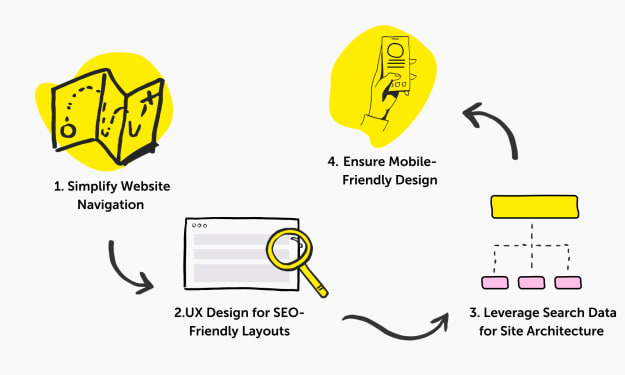
Introduction
Digital marketing encompasses the use of digital channels, such as search engines, social media, email, and websites, to promote a product or service to a vast audience at a more economical cost than conventional marketing methods. The essence of digital marketing lies in comprehending and engaging with the target audience.
Do’s
Utilize data and analytics:
Here are some tips for making the most of data and analytics:
1. Define key performance indicators (KPIs): Determine the KPIs that are most critical to your business and track them frequently to assess performance and spot trends.
2. Utilize analytics tools: Employ a variety of analytics tools, including web analytics, social media analytics, and marketing automation tools, to gain a deeper understanding of your audience’s behavior and the results of your marketing campaigns.
3. Analyze customer information: Analyze customer data to get a better sense of their behaviors, preferences, and pain points. This information can be used to enhance the customer experience and tailor your marketing efforts to better meet their needs.
4. Experiment and iterate: Regularly test and revise your marketing campaigns, using data and analytics to guide these changes. This will help you determine what is working well and what needs improvement and make data-driven decisions that drive growth and success.
Invest in quality content:
The following are some of the reasons why investing in quality content is crucial:
1. Enhanced Interaction: Valuable, high-quality content has a higher chance of being shared and interacted with, boosting your reach and visibility.
2. Improved Search Engine Positioning: Search engines favor websites that consistently publish high-quality, relevant content. Investing in quality content can enhance your website’s search engine ranking and attract organic traffic.
3. Establishing Trust and Credibility: Regularly publishing quality content solidifies your business as a trustworthy and credible source in your industry, building confidence with your target audience.
4. Distinction from Competitors: By continuously investing in quality content, you can set your business apart from competitors and position yourself as a thought leader in your field.
5. Long-term Success: Investing in quality content can drive long-term success for your business by raising brand awareness, establishing credibility, and attracting and retaining customers.
Know your target audience:
Here are some steps to help you identify your target audience:
1. Market Research: Collect data on your target audience through market research, surveys, and customer feedback to understand their demographics, behaviors, and interests.
2. Buyer Personas: Use the information gathered from market research to create comprehensive buyer personas, fictional representations of your ideal customers. This helps you better understand their needs and wants.
3. Online Behavior Monitoring: Observe how your target audience interacts with your website and social media platforms and the type of content they engage with and share.
4. Mindful of Target Audience: Keep your target audience in mind when creating marketing campaigns, developing content, and making business decisions to ensure your efforts align with their needs and interests.
5. Regular Reevaluation: The needs and interests of your target audience can change over time, so it’s essential to continuously reevaluate your understanding of them and make necessary changes.
Develop a strong online presence:
Below are some suggestions for enhancing your online presence:
1. Define Your Brand Identity: The initial step towards establishing a robust online presence is to clearly define your brand identity. This involves specifying your target market, recognizing what sets your business apart from competitors, and determining your tone and messaging.
2. Develop a Professional Website: A professional and user-friendly website is the cornerstone of any strong online presence. Make sure that your website has an appealing design, is easy to navigate, and is optimized for search engines.
3. Harness the Power of social media: Social media platforms are a potent tool for businesses looking to reach and interact with their target market. Select the most relevant platforms for your audience and consistently post high-quality content that aligns with your brand messaging.
4. Publish Valuable Content: Regularly publishing valuable content, such as blog posts, infographics, and videos, can help establish your business as an industry leader and build trust with your target market.
5. Interact with Your Audience: Respond to customer comments and feedback on your website and social media platforms, and actively seek out opportunities to engage with your audience. This helps build relationships and fosters a sense of community.
Don’ts
Ignoring the importance of SEO:
Here are some of the risks of ignoring SEO:
1. Low visibility in search engines: If you ignore SEO, your website may not be optimized for search engines, which means it may not appear at the top of search results when customers search for keywords related to your products or services.
2. Decreased organic traffic: Ignoring SEO can result in decreased organic traffic to your website, as customers are less likely to find and click through to your website from search engines. This can limit the number of opportunities you have to engage with customers and generate leads and sales.
3. Poor user experience: If you ignore SEO, your website may be poorly optimized for users, which can lead to a slow or clunky user experience. This can reduce customer engagement and limit the success of your marketing efforts.
4. Limited reach and audience: Ignoring SEO can limit your reach and audience, as your website may not be optimized for different devices and platforms, or for specific geographic locations. This can reduce the effectiveness of your marketing efforts and limit your ability to reach customers in different locations and on different devices.
5. Reduced competitiveness: Ignoring SEO can reduce your competitiveness, as your website may not be optimized for search engines and may not perform as well as those of your competitors. This can make it harder for you to stay ahead of the competition and achieve your marketing goals.
Failing to adapt to changing technologies and trends:
Here are some of the risks of failing to adapt to changing technologies and trends:
1. Decreased customer reach: As technologies and trends evolve, new platforms and channels emerge that can reach customers in new and different ways. Failing to adapt to these changes can limit your ability to reach customers and stay connected with them.
2. Reduced competitiveness: Failing to adapt to changing technologies and trends can make your business less competitive, as you may be missing out on opportunities to innovate, improve your marketing efforts, and keep pace with the competition.
3. Outdated marketing strategies: Failing to adapt to changing technologies and trends can result in outdated marketing strategies that no longer resonate with customers or effectively reach them. This can limit the success of your marketing efforts and reduce your ability to achieve your goals.
4. Decreased customer engagement: Failing to adapt to changing technologies and trends can result in reduced customer engagement, as your marketing messages and efforts may no longer feel relevant or interesting to customers.
5. Missed opportunities for growth: Failing to adapt to changing technologies and trends can limit your ability to grow and expand your business, as you may be missing out on new opportunities and markets that could drive growth and success.
Overloading promotions and sales pitches.
Here are some of the risks of overloading on promotions and sales pitches:
1. Decreased customer trust: Overloading customers with too many promotions and sales pitches can reduce their trust in your business, as they may perceive you as more interested in making a sale than in providing value or solving their problems.
2. Reduced customer engagement: Excessive promotions and sales pitches can lead to reduced customer engagement, as customers may feel overwhelmed or annoyed by the constant barrage of marketing messages.
3. Negative impact on brand image: Overloading customers with promotions and sales pitches can harm your business’s brand image, as they may associate your brand with pushy or inauthentic marketing tactics.
4. Decreased conversion rates: While promotions and sales pitches can drive conversions, overloading customers with too many messages can have the opposite effect, reducing conversion rates and limiting the success of your marketing efforts.
5. Missed opportunities for relationship building: Overloading customers with promotions and sales pitches can limit opportunities for relationship building, as you may be focusing too much on making a sale and not enough on building a relationship with your customers.
Neglecting mobile optimization:
Here are some of the risks of neglecting mobile optimization:
1. Decreased mobile user experience: A website or marketing campaign that is not optimized for mobile can lead to a poor user experience for mobile users, causing them to abandon the site or campaign and potentially harm your business’s reputation.
2. Missed opportunities: Neglecting mobile optimization can result in missed opportunities to reach a large and growing mobile audience, potentially limiting the growth and success of your business.
3. Lower search engine ranking: Search engines favor websites that are mobile-friendly, and neglecting mobile optimization can result in a lower search engine ranking, reducing visibility and organic traffic to your site.
4. Decreased conversion rates: A poor mobile user experience can result in decreased conversion rates, limiting the effectiveness of your marketing campaigns and potentially reducing revenue for your business.
5. Decreased customer satisfaction: Neglecting mobile optimization can result in a negative customer experience, potentially reducing customer satisfaction and loyalty.
Conclusion
In conclusion, the key to successful digital marketing lies in understanding the do’s and don’ts of the industry. By following best practices and avoiding common mistakes, businesses can maximize the impact of their digital marketing efforts and achieve their desired outcomes.
Whether it’s through developing a clear strategy, utilizing the latest technologies, or engaging with customers on social media, the secrets to success in digital marketing are there for the taking.
With the right approach, businesses can unlock the full potential of digital marketing and reap the benefits of a well-executed campaign.
Thanks for Reading….
About the Creator
Suresh R
I am a Software Developer working in Product Based Company at Chennai. And also, I wish to create a blog creation.






Comments
There are no comments for this story
Be the first to respond and start the conversation.